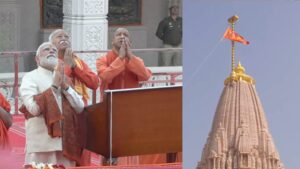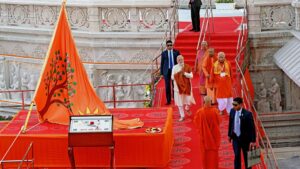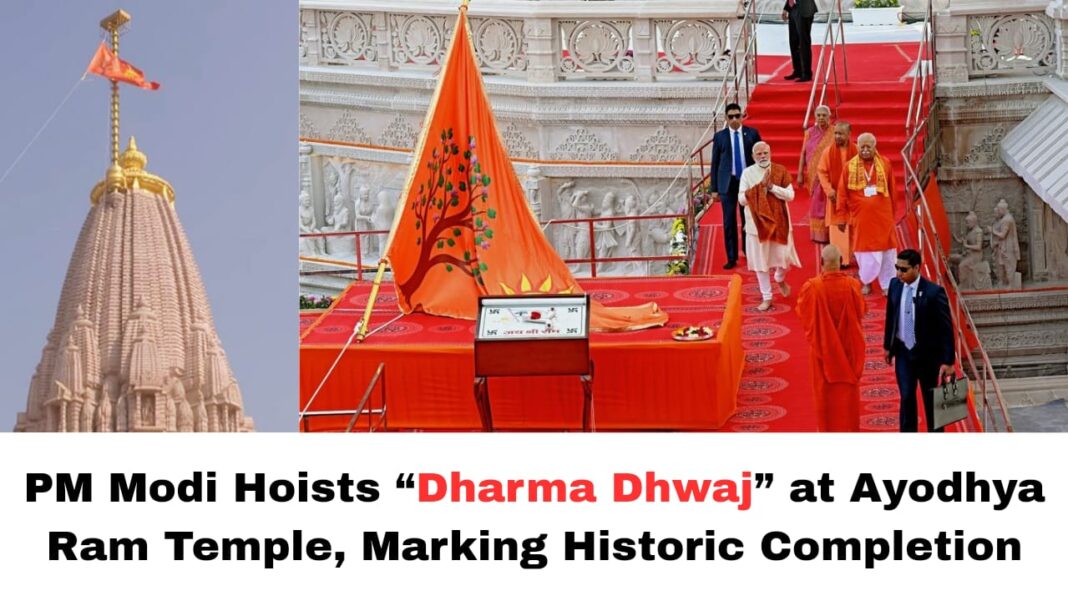Digital News Guru Uttar Pradesh Desk:
PM Modi Hoists Saffron ‘Dharma Dhwaj’ at Ayodhya’s Ram Janmabhoomi Temple
On 25 November 2025, Prime Minister Narendra Modi presided over a deeply symbolic ceremony in Ayodhya, where he hoisted a saffron flag—dubbed the “Dharma Dhwaj”—atop the spire of the Shri Ram Janmabhoomi Temple. This “Dhwajarohan” event is widely being seen as the ritual culmination of the temple’s construction and a moment of profound cultural resonance for many across India.
The Ceremony and Its Symbolism
The flag-hoisting took place during the auspicious Abhijeet Muhurat, a time considered highly favorable in Hindu tradition for performing sacred work. The saffron banner, measuring 22 feet by 11 feet, was carefully raised on a 42-foot pole at the temple’s shikhar (spire).
More than just a decorative piece, the flag is rich with religious symbols:
- A radiant Sun, which represents the Suryavansh lineage of Lord Ram.
- The symbol “Om”, associated with primordial cosmic sound and spiritual energy.
- The Kovidara tree, which carries deep meaning in Hindu tradition and is linked to Ramrajya.

In raising this flag, PM Modi described it as more than a religious symbol. In his remarks, he said the ceremony marks “the conclusion of a centuries-old resolve,” calling the moment a healing of “the wounds and pain of centuries.” He also spoke of truth triumphing over falsehood, tying the flag directly to the ideals of Ram Rajya—justice, righteousness, and moral governance.
Cultural, Spiritual & Political Undertones
For many, this event is a civilisational milestone. The Ram Janmabhoomi Temple has been a center of deep emotional, political, and spiritual significance for decades. While the pran-pratishtha (consecration of the Ram Lalla idol) took place in January 2024, the Dhwajarohan is being viewed as the ritual completion of the temple structure.
According to the temple trust and participants, hoisting the “Dharma Dhwaj” is akin to the spiritual “activation” of the entire temple — a symbolic affirmation that the temple is now fully sovereign.
The presence of dignitaries like RSS Chief Mohan Bhagwat, Uttar Pradesh Chief Minister Yogi Adityanath, and thousands of pilgrims reinforced the political and cultural weight of the moment.
In his speech, PM Modi invoked a vision for the future: by 2047 (when India marks 100 years of independence), he urged the nation to be not just materially strong, but spiritually grounded in the “eternal values” of Lord Ram. He also said India should “awaken the Ram within ourselves,” emphasizing an inner transformation rooted in spirituality and moral consciousness.
Deep Ritual Meaning
The design and timing of the ceremony are deliberate. The triangular saffron flag is not just decorative — its symbols (Sun, Om, Kovidara tree) carry deep spiritual meaning, representing divine lineage, cosmic order, and rootedness in tradition.

The choice of date is also significant: the ceremony coincided with Vivah Panchami, a traditional celebration of the celestial wedding of Lord Ram and Sita. Further, the timing aligns with important ritual muhurats, lending added spiritual weight to the event.
Reactions and Resonance
PM Modi’s words struck a strong chord. He described today as a “moment of cultural awakening,” signifying that this is not just a religious act, but a reaffirmation of India’s civilizational identity. Yogi Adityanath, in his address, echoed this sentiment, calling the flag a “proof that the light of Dharma is immortal.” Bhagwat, too, emphasized sacrifice, saying the saffron flag symbolizes “sacrifice” and continuity of faith.
In his address, PM Modi also reflected on India’s democratic journey: “We attained independence, but we could not free ourselves from the sense of inferiority,” he said, urging citizens to realize that “democracy is in our DNA.”
Architectural & Spatial Significance
The temple’s architectural design further amplifies the symbolism of the ceremony. The shikhar, where the flag was hoisted, is built in the North-Indian Nagara style, while the temple’s surrounding Parkota (circumambulatory enclosure) has elements inspired by South Indian design. According to PM Modi’s office, this architectural diversity reflects India’s cultural unity.
What It Means Going Forward
This Dhwajarohan is more than a ritual for many—it is being interpreted as a spiritual and civilizational moment. The flag is not just a marker of temple completion but is being framed as a beacon of Ram’s ideals: dharma, justice, truth, and harmony.

Politically, it reinforces the central role of Ayodhya and Ram Temple in India’s national narrative. For the government and its supporters, the flag-hoisting ties deeply into the vision of India rooted in its cultural heritage, not just its modern democratic identity.
Socially and spiritually, the event is likely to be remembered as a unifying moment for many Hindus, symbolizing the culmination of a long and emotionally charged journey that spans generations.
You May Also Read: Indian Woman From Arunachal Pradesh Alleges 18-Hour Detention, Passport Rejected in Shanghai








